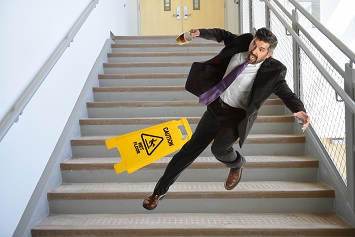At last year’s annual conference of the American Society of Safety Professionals (ASSP), ASSP’s outgoing President Jim Smith presented a session titled “The A1264.1 Standard: Wall and Roof Openings; Stairs and Guardrails/Handrails.” The American National Standards Institute (ANSI) Standards 1264.1 and 1264.2 could be helpful for facilities management professionals looking to design their workplaces with the aim of preventing falls—but there are advantages and disadvantages to these voluntary standards.

As the Director of Risk Control Services for Arthur J. Gallagher & Co., Smith also served on the standard committee that revised ANSI Standard 1264.1 in 2017. This voluntary standard, formally called ANSI Standard 1264.1—Safety Requirements for Workplace Walking/Working Surfaces and Their Access; Workplace, Floor, Wall and Roof Openings; Stairs and Guardrail/Handrail Systems, coupled with ANSI Standard 1264.2—Standard for the Provision of Slip Resistance on Walking/Working Surfaces, informs industry practices for the prevention of slips, trips, and falls (STFs) pursuant to OSHA’s walking-working surface regulations.
Since these standards are voluntary, however, many facilities professionals may wonder if implementing their provisions in addition to compliance with OSHA rules is necessary or beneficial, and Smith’s session explored some of these common concerns.
The Staggering Costs of STFs
With the ongoing problem of STFs in the workplace, determining whether the ANSI standards actually help a company’s fall prevention program and ultimately its bottom line is of critical importance. Tellingly, a large number of safety professionals in attendance at the session indicated that they had investigated STF incidents within the last 90 days.
According to the 2018 Liberty Mutual Workplace Safety Index, STFs counted for 3 of the top 10 causes of the most disabling workplace injuries in the United States. Falls on the same level comprised 19.2 percent of all injuries, resulting in $11.2 billion in direct costs for employers. Falls to lower levels comprised 10 percent of the injuries, costing $5.9 billion, and slips or trips without falls comprised 3.9 percent of injuries, resulting in costs of $2.3 billion.
Significantly, these numbers were all increases from the 2013 data, indicating that the STF problem is not going away any time soon. But can the ANSI standards help you lessen the risks of STFs and advance an effective fall prevention program at your workplace?
Some Advantages of ANSI Standard 1264.1
According to Smith, one of the biggest benefits of ANSI Standard 1264.1 is that by establishing minimum safety requirements and specifications for walking-working surfaces, such as stairway systems, guardrail systems, safety gates, floor openings, and falling objects, it helps safety professionals advocate for better-designed surfaces to upper management. Though OSHA sets forth basic requirements for these walking-working surfaces in 29 Code of Federal Regulations (CFR) 1910 Subpart D, the standard fleshes out the rules and provides concrete parameters for general industry to follow.
In a similar vein, ANSI Standard 1264.1 requires facilities to perform a fall hazard assessment. By looking to relevant claims data as part of this assessment, facilities professionals can use this information to obtain financial commitments and support from management for greater fall protections for workers.
… and Some Disadvantages
Nevertheless, ANSI Standard 1264.1 isn’t perfect. Smith indicated that he believes the standard could have gone into more detail, especially with regard to requirements for illumination on stairways and walking surfaces, access and working surfaces on machinery, the accumulation of debris or water on stairs, and flooring hazards for same-level surfaces. Additionally, more could have been done to address the increasingly common hazard of distracted walking.
Some Notes on ANSI Standard 1264.2
Regardless of the pros and cons of ANSI Standard 1264.1, Smith emphasized that it must be considered in tandem with ANSI Standard 1264.2 regarding slip resistance of the walking-working surfaces. Slip resistance hazards are common contributory causes of STFs in general industry and include problems with floor surface characteristics, foreign debris, environmental factors, floor care and maintenance, and footwear. ANSI Standard 1264.2 aims to address these issues by prescribing standards of practice for mats and runners, housekeeping, warnings, controlling access, and selection and treatment of flooring and by setting criteria for slip resistance and equipment testing.
The Bottom Line
Ultimately, Smith urged attendees to incorporate both ANSI Standards 1264.1 and 1264.2 into their fall prevention strategies for their workplaces but outlined a mindful approach for doing so. By weighing the strengths and weaknesses of the standards, facilities professionals can use them as effective tools in helping their safety teams achieve compliance with OSHA’s walking-working surface regulations while protecting workers and their facilities from the increasing risks and costs of STFs in general industry.
